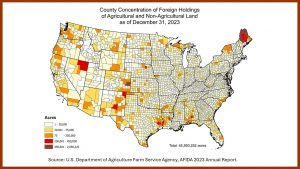
U.S. milk production was up 3% in November year over year and up 2.3% in September and October.
“That’s more milk than the market can handle to keep the milk price up,” Bob Cropp, a dairy economist at the university, said in the latest “Dairy Situation and Outlook” podcast.
There’s expansion in the industry, with cow numbers up 62,000 head year over year in November. And production per cow was up 2.3% year over year in November, a large increase from the trend of 1.4% to 1.5%, he said.
“So that combination is a lot of milk,” he said.
Futures prices for Class III milk on Dec. 31 were at $17.49 per hundredweight for February, $17.46 for March and $17.38 for April.
But unless farmers are planning to slow production or there’s another round of government food box distributions, Cropp doesn’t think those prices will even be in the $16s, he said.
Plugging in current cheese and whey prices, Class III would be in the low $15s, he said.
“I think the markets, futures, are over-optimistic at least for the first quarter and maybe the first half of the year,” he said.
Fellow university economist Mark Stephenson agreed, saying cheddar cheese prices have settled out at about $1.60 a pound for blocks.
“That’s not moving much of anywhere, but that is essentially at world market prices. So at that kind of price, maybe with a small discount, we can sell some cheese on export markets,” he said.
But cheese and whey prices imply a Class III price well below $17.50, he said.
Milk production is probably going to continue to be pretty high in the first quarter of 2021, Cropp said.
A new cheese plant that will process 6 million to 8 million pounds of milk a day is coming online in Michigan, and capacity is being added to other cheese plants, Stephenson said.
“So perhaps we can handle the milk,” he said.
The worrisome thing is that it’ll take exports to clear the market, and that implies downward pressure on prices, he said.
Domestic markets can’t handle much more than a 1% increase in milk production, Cropp said.
“Exports have been strong but not enough to handle the 2.3-3% growth in milk production you see right now,” he said.
The recent announcement of Section 32 government purchases for $50 million in butter could help. That would be close to 2% of butter production for the year and could draw down stocks if it doesn’t cannibalize a lot of commercial sales, Stephenson said.
“So that could help provide some support for sure for butter prices,” he said.
But it’s not the government food boxes that have been in place this year, and they aren’t likely to continue under the new administration, he said.
His guess is the new administration will use more traditional food-insecurity measures, such as the Supplemental Nutrition Assistance Program. But that gives people discretion about their purchases, and they might not buy a block of cheese — which was in the food boxes, he said.























